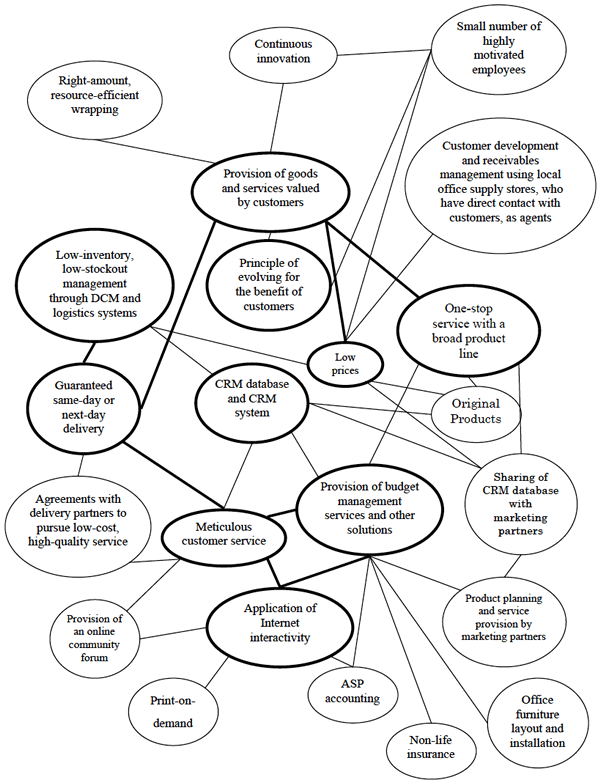Winners / Selection Rationale
ASKUL Corporation
2002 2nd Porter Prize Winner Mail Order of General Merchandise
Unique target market in the form of small and medium enterprises and continuous innovation in its operations
Unique Value Proposition
The definitive aspect of ASKUL's strategy is that it provides value that was previously nonexistent in the industry. The strategy targets small and medium enterprises that normally purchase office supplies at suggested retail prices from local stores and offers them a wide selection of products at low prices and with rapid delivery. More recently, the company is not only selling goods, but als2o applying the interactive communications made possible by the Internet to offer customer budget management and other solutions. This new value proposition was made possible by innovative systems. These systems opened the door to the possibility of developing customers among the myriad of small and medium enterprises by employing local office supply stores as "agents" and to the possibility of putting to work the face-to-face relationship between local office supply stores and customers to manage receivables.
Consistency of Strategy Over Time
ASKUL's product selection and services have rapidly expanded as the company has recognized customer needs. This is demonstrated in the company's construction of a system that evolves - the result of the innovative concept, "ASKUL=Platform." As a "platform," ASKUL controls the Demand Chain Management system and the Customer Relationship database and system. It then serves the needs of small and medium enterprises by making this infrastructure available to trading companies, manufacturers, financial services companies and other "marketing partners."
While the goods and services, as well as the companies participating in ASKUL's value chain change, there is continuity in the strategy. ASKUL's target customer, small and medium enterprises, has been the same since the company got its start as a division of the office supply manufacturer, PLUS Corporation. And the same is true of the system of collaborating with agents. What has changed is the value proposition. Whereas only PLUS products were offered under the original strategy, the company made a strategic modification over 1994-95 to offer the products that customers want, regardless of the manufacturer. The value proposition of providing the goods that customers want at low prices and with rapid delivery has remained the same since.
Profitability
ASKUL made its initial public offering on the over-the-counter market in 2000 and used the capital it gathered to consolidate its distribution centers and introduce a Demand Chain Management system. With the help of those investments, ASKUL's return on invested capital, which fell below the prior-year result in 2000, has consistently exceeded the industry average by a wide margin. The same can be said of ASKUL's profit margin.
Return on invested capital (ROIC) (Unit = percentage point)
Return on invested capital = Operating income / Average invested capital
Return on sales (ROS) (Unit = percentage point)
Return on sales =Operating income / Net sales
While the goods and services, as well as the companies participating in ASKUL's value chain change, there is continuity in the strategy. ASKUL's target customer, small and medium enterprises, has been the same since the company got its start as a division of the office supply manufacturer, PLUS Corporation. And the same is true of the system of collaborating with agents. What has changed is the value proposition. Whereas only PLUS products were offered under the original strategy, the company made a strategic modification over 1994-95 to offer the products that customers want, regardless of the manufacturer. The value proposition of providing the goods that customers want at low prices and with rapid delivery has remained the same since.
Profitability
ASKUL made its initial public offering on the over-the-counter market in 2000 and used the capital it gathered to consolidate its distribution centers and introduce a Demand Chain Management system. With the help of those investments, ASKUL's return on invested capital, which fell below the prior-year result in 2000, has consistently exceeded the industry average by a wide margin. The same can be said of ASKUL's profit margin.
Return on invested capital (ROIC) (Unit = percentage point)
| Difference from industry averag over 5 year period |
Difference from industry average, by year | ||||
| 1997 | 1998 | 1999 | 2000 | 2001 | |
| 37.3%P | 69.12%P | 116.01%P | 119.43%P | 21.3%P | 26.32%P |
Return on sales (ROS) (Unit = percentage point)
| Difference from industry average over 5 year period |
Difference from industry average, by year | ||||
| 1997 | 1998 | 1999 | 2000 | 2001 | |
| 1.35%P | 4.72%P | 2.39%P | 0.10%P | -0.37%P | 1.72%P |
Activity System Map

Winners PDF
- 2002 Porter Prize Winners PDF (All of the award company in this year are published. )






